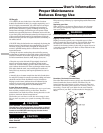
32-5037-01 5
User’s Information
Regular Dealer Maintenance
1.GENERAL INSPECTION –
During startup and regular annual mantenance, a heating
dealer should inspect the furnace installation for the follow-
ing items:
• The exterior of the furnace should be inspected for signs
ofexcessive heat such as discoloration of materials and
damage from rust or corrosion.
• Confirm the base or frame supporting the furnace is level
and in sound condition.
• Signs of excessive rust, corrosion pitting, and holes.
• Signs of condensation or moisture leakage (sometimes
indicated by soot or condensate streaks).
• Evidence of structural damage, and loose or disconnected
piping joints.
• Free movement of the vane of the barometric damper
without binding or interference. If any problems are
evident, make repairs immediately. Do not operate the
furnace until repairs are made.
• The furnace flue pipe, vent connector, barometric damper,
and chimney should be inspected for:
a. All flue product carrying areas external to the furnace
(i.e. chimney, vent connector) are clear and free of
obstruction.
b. The vent connector is in place, slopes upward and is
physically sound without holes or excessive corrosion.
c. The return air duct connection(s) is physically sound,
is sealed to the furnace and terminates outside the
space containing the furnace.
d. The physical support of the furnace should be sound
without sagging, cracks, gaps, etc., around the base so
as to provide a seal between the support and the base.
e. There are no obvious signs of deterioration of the
furnace.
2. BLOWERS – The blower size and speed determine the
air volume delivered by the furnace. The blower motor
bearings are factory lubricated and under normal
operating conditions do not require servicing. Annual
cleaning of the blower wheel and housing is recom-
mended for maximum air output, and this must be
performed only by a qualified servicer or service agency.
3. BURNER – Burner Compartment: On the highboy and
lowboy furnace models, the burner compartment can be
inspected by removing the front door of the furnace.
Look for signs of excessive heat, such as discoloration of
components, damage to material from rust or corrosion,
soot or carbon build-up, and evidence of fuel oil leakage.
4. HEAT EXCHANGER / FLUE PIPE – These items must
be inspected for signs of corrosion, and/or deterioration
at the beginning of each heating season by a qualified
service technician and cleaned annually for best opera-
tion.
6. CIRCUIT PROTECTION – If blower or oil burner fail to
operate, the cause could be the circuit breaker or a loose
or blown fuse. Replace fuse or reset circuit breaker.
7. OPERATION – Your warm air furnace should not be
operated in a corrosive atmosphere. Paint solvents,
cleaning chemicals, spray propellants, and bleaches
should not be used in the vicinity of the furnace during
normal operation.
8. CONDENSATE DRAINS – If you have a cooling coil
installed with your furnace, condensate drains should be
checked and cleaned periodically to assure that conden-
sate can drain freely from coil to drain. If condensate
cannot drain freely water damage could occur.
Never stop the cooling system
by shutting off the main power.
If the main power to your air conditioner is ever disconnected
for more than three hours, turn off the thermostat. Then wait
for at least three more hours after the power has been
restored before turning the thermostat back on. Failure to
follow this procedure could result in damage to your air
conditioning system.
NOTICE: A qualified heating dealer MUST service the
oil burner and inspect the heat exchanger in this
furnace at least once a year.
To successfully service this oil furnace, the following
recently (within the last year) calibrated instruments
must be available.
• Smoke spot test kit with Bacharach-type oil burner
smoke scale
• Carbon dioxide (CO2) and carbon monoxide (CO) test kit
or analyzer
• Flue gas temperature measuring instrument
• Draft gauge, capable of measuring 0.01 to 0.25 in. W.G.
draft (Draft is the pressure differential between the static
pressure measured in the vent pipe, or just above the
combustion chamber, and the indoor atmospheric
pressure. Under normal operating conditions, it will have
a negative value, i.e. the pressure in the combustion
chamber and the vent system are less than room air
pressure.)
• Multimeter (analog or digital type)
• Oil pressure gauge, capable of measuring at least 0 to
200 PSIG
• Burner electrode and nozzle setting gauge
Be familiar with the correct operation of these
instruments as well as how to adjust the oil burner
settings (refer to burner manufacturer’s literature).
▲
WARNING
!
CARBON MONOXIDE POISONING HAZARD
Failure to follow the installation and operation instructions
for the venting system’s operation could result in carbon
monoxide poisoning or death.
▲
WARNING
!
Failure to follow these instructions may result in fire or
explosion causing property damage, personal injury, or
loss of life.










